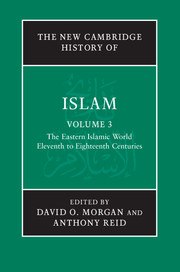Book contents
- Frontmatter
- Introduction: Islam in a plural Asia
- PART I THE IMPACT OF THE STEPPE PEOPLES
- 1 The steppe peoples in the Islamic world
- 2 The early expansion of Islam in India
- 3 Muslim India: the Delhi sultanate
- 4 The rule of the infidels: the Mongols and the Islamic world
- 5 Tamerlane and his descendants: from paladins to patrons
- PART II THE GUNPOWDER EMPIRES
- PART III THE MARITIME OECUMENE
- PART IV THEMES
- Glossary
- Bibliography
- Index
- References
1 - The steppe peoples in the Islamic world
from PART I - THE IMPACT OF THE STEPPE PEOPLES
Published online by Cambridge University Press: 28 March 2011
- Frontmatter
- Introduction: Islam in a plural Asia
- PART I THE IMPACT OF THE STEPPE PEOPLES
- 1 The steppe peoples in the Islamic world
- 2 The early expansion of Islam in India
- 3 Muslim India: the Delhi sultanate
- 4 The rule of the infidels: the Mongols and the Islamic world
- 5 Tamerlane and his descendants: from paladins to patrons
- PART II THE GUNPOWDER EMPIRES
- PART III THE MARITIME OECUMENE
- PART IV THEMES
- Glossary
- Bibliography
- Index
- References
Summary
Until the opening of the eleventh century CE, the eastern frontiers of the Islamic world had been fairly stable. The frontier region between what is now eastern Afghanistan and north-western India, essentially the Indus Valley, still remained fluid, and was now to form the springboard for Muslim expansion further into India under the Ghaznavids and Ghūrids. To the north-east, the ancient Iranian kingdom of Khwārazm on the lower Oxus and, above all, the equally Iranian Sāmānid emirate in Khurāsān and Transoxania, which flourished for almost two centuries, constituted bastions of Islamic faith and society against the peoples of the Eurasian steppes. See Map 1 for this chapter.
However, the years after c. 1000 CE witnessed for this region an irruption of peoples from the steppe and forest lands beyond these Islamic outposts of Khwārazm and Transoxania, first of Turks and then, in the second half of the twelfth century, of Mongols and Turco-Mongols in the shape of the Qara Khitay and then, after 1217, of Chinggis Khan’s hordes. New ethnic elements were thus injected into the eastern Islamic world, hitherto dominated ethnically mainly by Iranians, and politically and culturally by a symbiosis of the Persian and Arabic literary and governmental traditions. These incursions from Inner Asia had effects on the older Islamic lands – in the case of the Mongol invasions, cataclysmic ones – but in the longer term, the perdurable, absorptive powers of Islamic religion and culture exercised their effects on the incomers.
- Type
- Chapter
- Information
- The New Cambridge History of Islam , pp. 19 - 77Publisher: Cambridge University PressPrint publication year: 2010
References
- 2
- Cited by

